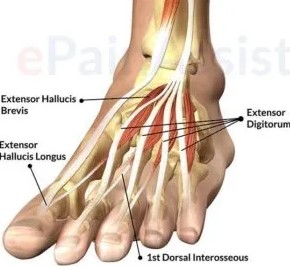Dealing with Extensor Tendon Injuries in the Foot
 Dealing with extensor tendon injuries in the foot can be a difficult and painful process. Extensor tendons are responsible for extending the toes and the foot, and when they become injured, it can cause a great deal of pain and difficulty in walking. Fortunately, there are a variety of treatments available to help manage the pain and restore the function of the foot. This article will discuss the causes, symptoms, and treatments of extensor tendon injuries in the foot.
Dealing with extensor tendon injuries in the foot can be a difficult and painful process. Extensor tendons are responsible for extending the toes and the foot, and when they become injured, it can cause a great deal of pain and difficulty in walking. Fortunately, there are a variety of treatments available to help manage the pain and restore the function of the foot. This article will discuss the causes, symptoms, and treatments of extensor tendon injuries in the foot.
Understanding the Causes and Risk Factors of Extensor Tendon Injuries in the Foot
Extensor tendon injuries in the foot are a common and often painful condition that can cause significant disruption to a person’s daily activities. Understanding the causes and risk factors of these injuries can help people take steps to prevent them.
The extensor tendons are located on the top of the foot and are responsible for extending the toes and foot. When these tendons become injured, it can cause pain, swelling, and difficulty walking. Common causes of extensor tendon injuries include direct trauma, such as a fall or a blow to the foot, as well as overuse or repetitive strain.
Certain activities can increase the risk of extensor tendon injuries. These include activities that involve running, jumping, or kicking, as well as activities that involve repetitive motions, such as running on a treadmill or playing a sport. People who wear ill-fitting shoes or have poor foot mechanics, such as flat feet, are also at an increased risk of developing an extensor tendon injury.
In addition, certain medical conditions can increase the risk of extensor tendon injuries. These include diabetes, rheumatoid arthritis, and gout. People who have these conditions should take extra care to protect their feet and be aware of any changes in their feet that could indicate an injury.
Finally, age can be a factor in extensor tendon injuries. As people age, their tendons become less flexible and more prone to injury. Therefore, it is important for older adults to take extra care to protect their feet and be aware of any changes in their feet that could indicate an injury.
By understanding the causes and risk factors of extensor tendon injuries in the foot, people can take steps to prevent them. This includes wearing properly fitting shoes, avoiding activities that involve repetitive motions, and taking extra care to protect the feet if you have a medical condition that increases the risk of injury.
Diagnosing and Treating Extensor Tendon Injuries in the Foot: What to Expect from Your Physician
If you have suffered an extensor tendon injury in your foot, you may be wondering what to expect from your physician. This article will provide an overview of the diagnosis and treatment of extensor tendon injuries in the foot.
The first step in diagnosing an extensor tendon injury is to take a thorough medical history. Your physician will ask questions about the mechanism of injury, the location of the pain, and any other symptoms you may be experiencing. Your physician will also perform a physical examination of the affected area. This may include palpation of the tendon, range of motion testing, and imaging tests such as X-rays or an MRI.
Once the diagnosis is confirmed, your physician will discuss treatment options with you. Treatment for extensor tendon injuries typically involves rest, ice, compression, and elevation (RICE). Your physician may also recommend physical therapy to help strengthen the affected area and improve range of motion. In some cases, surgery may be necessary to repair the tendon.
Your physician may also prescribe medications to help reduce pain and inflammation. Nonsteroidal anti-inflammatory drugs (NSAIDs) are commonly used to treat extensor tendon injuries. Your physician may also recommend corticosteroid injections to reduce inflammation and pain.
Finally, your physician may recommend lifestyle modifications to help reduce the risk of re-injury. This may include avoiding activities that put stress on the affected area, wearing supportive shoes, and stretching regularly.
By following your physician’s instructions, you can help ensure a successful recovery from an extensor tendon injury in your foot. With proper diagnosis and treatment, you can get back to your normal activities in no time.Dealing with extensor tendon injuries in the foot can be a difficult and lengthy process. It is important to seek medical attention as soon as possible to ensure proper diagnosis and treatment. Treatment may include rest, immobilization, physical therapy, and in some cases, surgery. With proper care and rehabilitation, most people can make a full recovery and return to their normal activities.